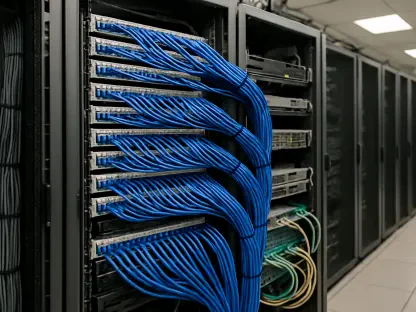Imagine a future where the vastness of space is no longer a barrier to high-speed data processing and storage, where astronauts and researchers can access cloud computing capabilities similar to those on Earth, directly from orbit. This vision is rapidly becoming a reality with groundbreaking initiatives aimed at establishing orbital data centers. A pivotal project in this realm involves a collaboration to deploy a high-performance data center node on the International Space Station (ISS) by 2027. This ambitious endeavor promises to redefine how data is managed in space, supporting everything from scientific research to commercial space operations. As technology continues to advance, the potential for a connected, data-intensive space environment is sparking excitement across the industry, setting the stage for a new era of space exploration and innovation.
Pioneering Orbital Data Infrastructure
Laying the Groundwork for In-Space Computing
The journey toward orbital data centers has taken a significant leap forward with a major partnership focused on deploying a cutting-edge node on the ISS within the next two years. Announced in Paris, France, on September 16, this initiative aims to enhance data storage and processing capabilities for spacecraft, astronauts, and researchers. Spearheaded by industry leaders, the project is set to introduce the AxODC Node ISS, a system designed to handle complex computational tasks directly in orbit. This node is envisioned as the cornerstone of a distributed network of orbital data centers, facilitating advanced cloud-computing applications. By integrating artificial intelligence and machine learning algorithms, the system will enable real-time data analysis, a critical need for modern space missions. The collaboration highlights a shared commitment to transforming space into a digitally connected frontier, mirroring the capabilities found on Earth.
Building on Past Successes and Innovations
Complementing this vision are prior experiments that have already tested the feasibility of in-space data solutions. A few years ago, a solid-state drive was delivered to the ISS for data storage and processing trials, marking an early step in this domain. More recently, in August, another data center unit was sent to the station through a partnership with a leading open-source software specialist. These efforts have laid a robust foundation for the upcoming AxODC Node ISS, demonstrating that space-based computing is not just a concept but a practical reality. Once fully interconnected, the planned network of orbital data centers is expected to offer substantial capacity and power, supporting intricate tasks that were previously unimaginable in orbit. This progression reflects a clear trend toward expanding infrastructure to meet the escalating demands of space research and operations, ensuring that data handling keeps pace with exploration ambitions.
Technology and Partnerships Driving the Future
Harnessing Cutting-Edge Hardware and Optical Links
At the heart of this transformative project lies an array of advanced technologies designed to push the boundaries of orbital computing. The AxODC Node ISS will feature an optical communications terminal compatible with high-speed data links, setting the stage for a data-rich space environment. This technology, combined with petabyte-scale servers and high-performance spaceflight computing systems, represents a significant advancement in hardware capabilities. Contributions from various technology partners ensure that the node integrates seamlessly with both internal and external ISS payloads. Industry experts have emphasized the potential of these optical links to accelerate cloud computing and AI-driven decision-making in space. The focus on high-speed data transmission addresses a critical need for real-time processing, which is essential for both scientific endeavors and commercial activities in orbit, marking a pivotal shift in how data is managed beyond Earth.
Collaborative Vision for a Connected Space
The collaborative nature of this initiative underscores a unified vision for the future of space computing. Multiple stakeholders, from space infrastructure companies to technology innovators, are working together to create a scalable and efficient data center network in orbit. This partnership reflects a broader industry consensus on the importance of integrating advanced computing and connectivity in space. Leaders in the field have described this effort as ushering in a new era of computing and storage capabilities, highlighting the optimism surrounding the project’s impact. The diversity of expertise—from distributed computing networks to optical connectivity and hardware innovation—illustrates a multifaceted approach to tackling the challenges of in-space data management. As this network takes shape, it is poised to support a wide range of applications, positioning space as a frontier for digital innovation and setting a benchmark for future orbital infrastructure.
Reflecting on a Digital Frontier in Orbit
Shaping the Legacy of Orbital Data Centers
Looking back, the strides made in deploying the AxODC Node ISS by 2027 stand as a testament to human ingenuity and collaboration in the realm of space technology. The integration of high-performance computing hardware with advanced optical communications marked a historic milestone in transforming data handling beyond Earth’s atmosphere. This project not only enhanced the capabilities of the ISS but also paved the way for a connected, data-intensive space environment that mirrored terrestrial digital landscapes. The efforts of various partners demonstrated that space could indeed become a hub for innovation, supporting complex computational tasks with unprecedented efficiency. Reflecting on these achievements, it became clear that this initiative was a defining moment in the evolution of space exploration and commercial operations.
Charting the Path Forward for Space Innovation
As the impact of these orbital data centers unfolded, attention turned to the actionable steps needed to sustain and expand this digital frontier. Future considerations included scaling the network to accommodate more nodes and enhancing interoperability with emerging space missions. The success of this project highlighted the need for continued investment in technologies that bolster data transmission and processing in orbit. Additionally, fostering international collaboration emerged as a key priority to ensure that the benefits of in-space computing reached a global scale. By building on the foundation laid by the AxODC Node ISS, the space industry could anticipate further breakthroughs, driving innovation and opening new possibilities for research and commerce. This forward-looking approach promised to solidify space as a vital arena for technological advancement in the years that followed.









